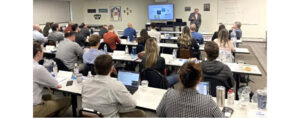On-demand vehicles and ride-sharing will continue to have an impact on our industry, but how it will impact your business will depend greatly upon your company’s organizational views
What happens when vehicle ownership reaches its peak?
With a rising cost of car ownership and increasing accessibility to urban and shared mobility options, passenger vehicle sales are predicted to peak out and suffer a swift descent as consumers increasingly move toward these shared transportation options.

In anticipation of “peak auto,” many automakers are making drastic pivots and reinventing themselves into mobility companies — hoping to cash in on the changing consumer preferences in urban transportation.
Of course, like the many other disruptions occurring in automotive, properly predicting when this will occur is critical for automakers, suppliers, and investment firms to avoid capital-intensive investments and to gradually shift business models, which requires the development of effective long-term strategies for future operations.
Evolving scenarios for peak auto
Industry forecasts predict that global light vehicle production will hit 100 million by 2030. However, most of this growth is being driven by China, India, Eastern Europe, and other emerging markets due to the growing middle class in these regions of the globe.
Recognizing the nuances of the statistics and accounting for recent set-backs and changing consumer mindsets from the COVID pandemic, automakers in mature auto markets are starting to throttle back their projects. This pull-back leads industry analysts and insiders to debate the idea of “peak auto production” altogether.
Decreasing industry production
Densely-populated metropolitan areas are the most likely to convert to shared mobility for the service’s practicality, convenience, and financial benefits.
The simple app-based infrastructure provides riders with quick, easy, and affordable rides that allow passengers to work, talk on the phone, check social media, and get where they need to go — all in relative privacy.
According to a recent Reuters study, this alternative has become so attractive that nearly a quarter of U.S. adults have sold or traded in a vehicle in the last months, with 9 percent of that group turning to ride-sharing services like Uber and Lyft as their main way to get around.
Cost plays a big role in the argument for peak auto. When you compare the cost of shared mobility to the cost of vehicle ownership (monthly payment, insurance, parking, maintenance, etc.), ride sharing can be a much more economical option for most consumers.
Generation Y consumers are now the most promising demographic for ride-sharing companies and quickly become the major force shaping market requests in the United States. With many shouldering considerable debt from school loans, the cost of ownership is high enough to avoid owning a vehicle and opt instead for shared mobility alternatives.
Another reason for decreased production is an increase in the average lifespan of new vehicles thanks to electrification. With 100 fewer moving parts, electric vehicles (EV) last twice as long as the traditional internal combustion engine (ICE). EVs can average 400,000-plus miles in their lifetime, and Tesla is working toward a 1-million-mile battery. This means private car owners will have to replace vehicles less often, leading to decreased production.
Another benefit of a well-developed car-sharing infrastructure is that it has the potential to free up valuable space for pedestrians and other traffic participants. It also reduces the pressure placed on public transport services that can become overcrowded with growing populations.
Increasing industry production
New mobility services may result in a decline in private vehicle sales. Still, this decline is partially offset by sales in shared vehicles that need to be replaced more often due to higher utilization and related wear and tear.
Vehicle scrappage is determined by miles driven. Each on-demand vehicle will travel more miles than the average household car, but unless carmakers do something to extend the vehicle’s life greatly, vehicle life span (in terms of miles driven) will not significantly change.
Many also believe the big driver of increased vehicle production will come from the distance on-demand vehicles cover between individual passenger trips. For example, recent studies have shown that nearly 50 percent of the miles that Uber drivers log in New York City don’t include passengers — it’s the time drivers take to get to their passengers in the first place. As a result, vehicle miles driven will continue to increase along with the demand for ride-sharing services, thus driving increased vehicle production.
Peak Auto: Don’t ignore the changes
There’s no doubt that on-demand vehicles and ride-sharing will continue to have an impact on our industry, but how it will impact your business will depend greatly upon your company’s organizational views.
Businesses that engage in longer-term scenario planning earlier on, with a robust strategic process, will benefit from the changing market and achieve greater success in the new market — and the sooner, the better. Companies who seize this opportunity sooner rather than later will have far more options and will have a leg up on the competition in their efforts to maximize value in these times of significant technology disruption.
As a strategic automotive consultant, Paul Eichenberg collaborates with automotive suppliers to develop and execute creative, innovative solutions to the complex challenges facing their industry. His experience working in the automotive supply industry makes him an expert in existing problems, and his passion for the future of automotive technology makes him an insightful resource and thought leader.






Comments are closed.